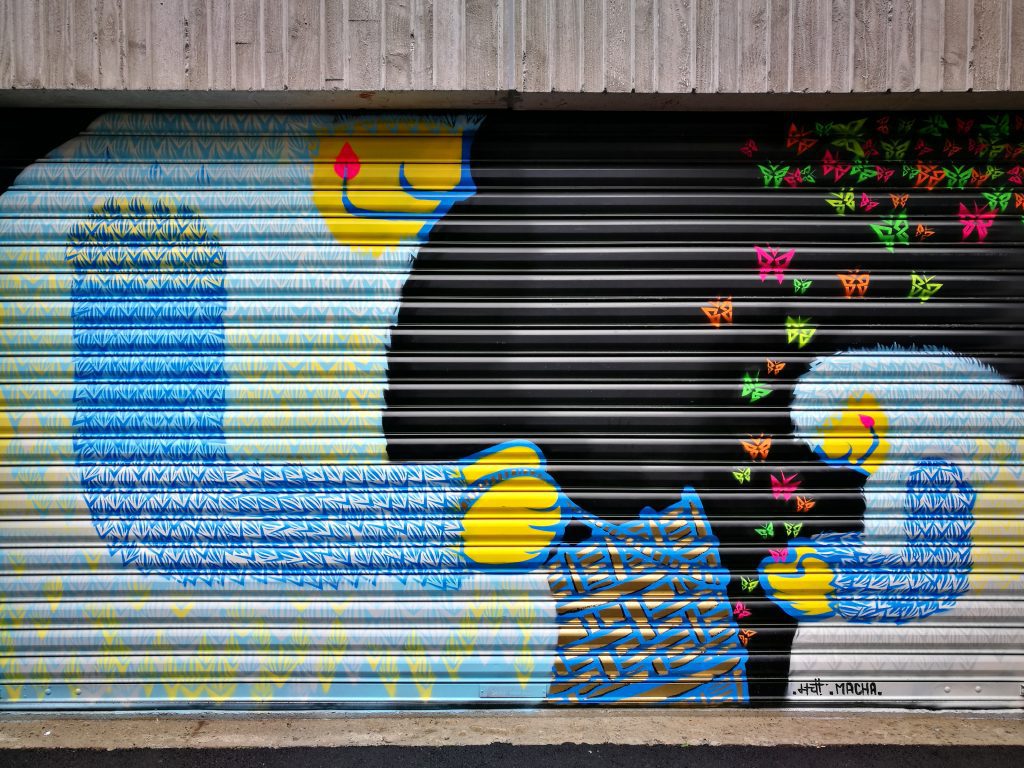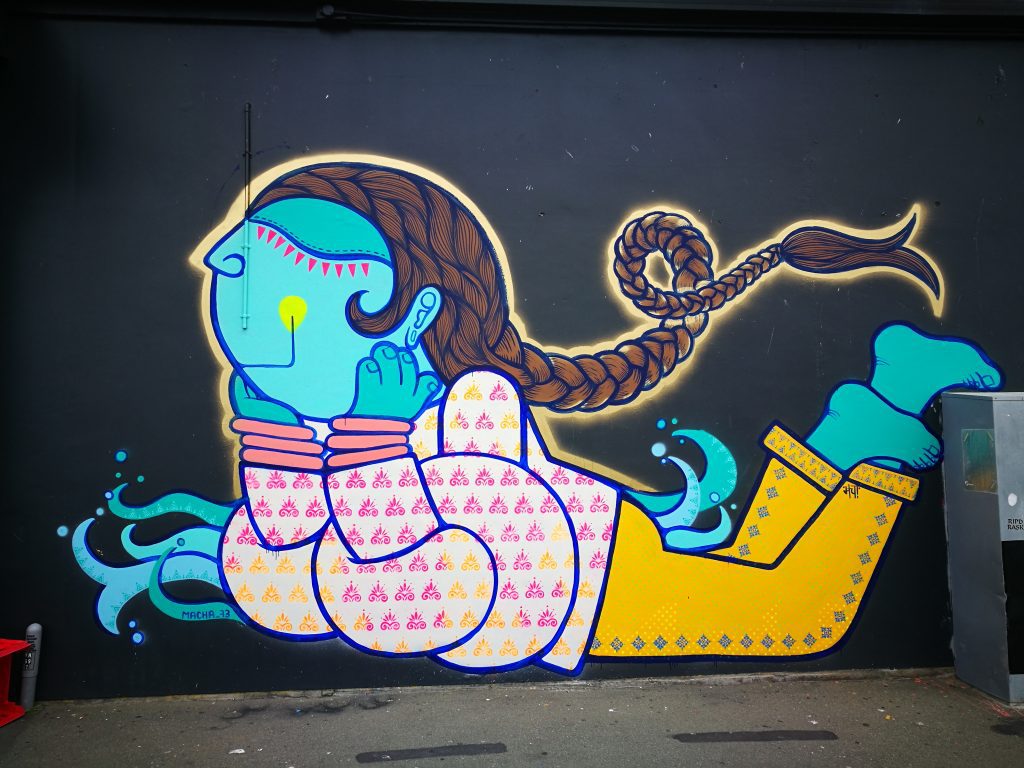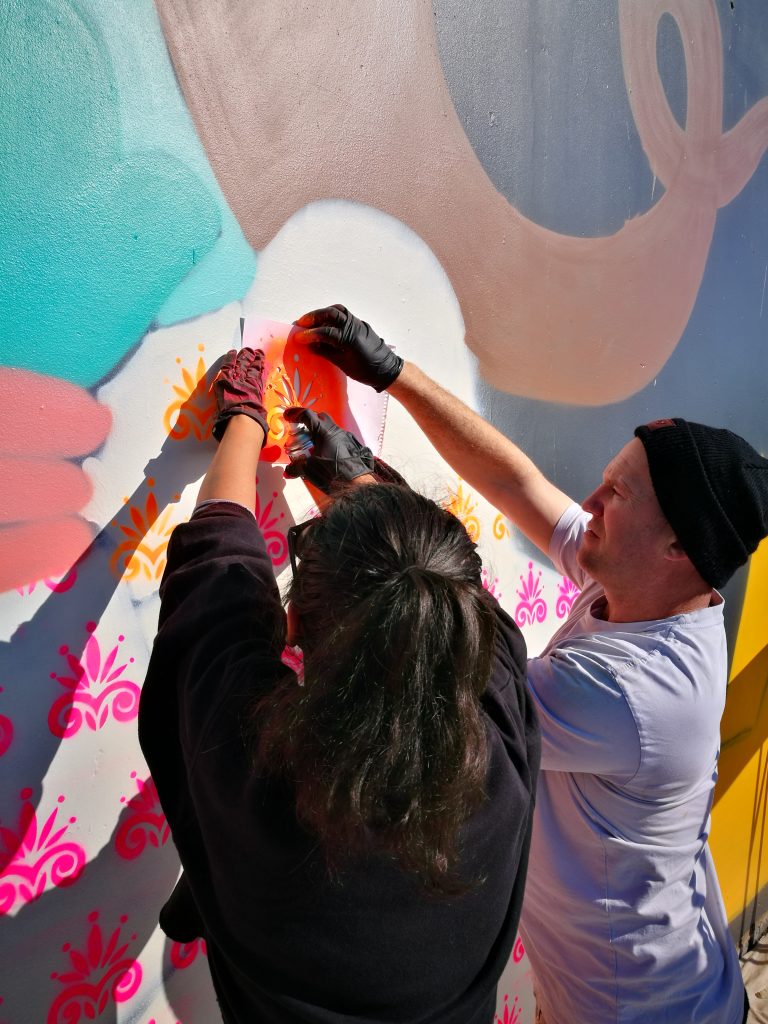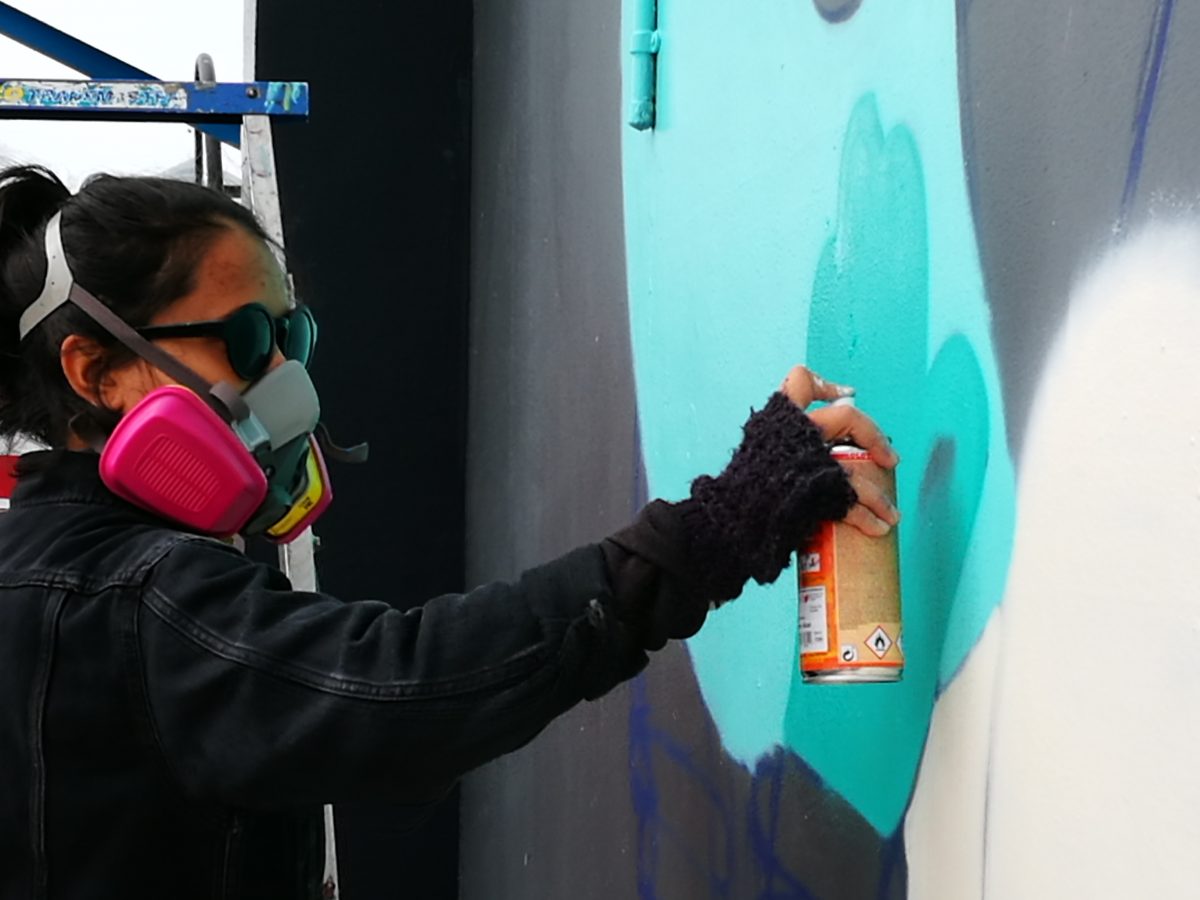Shraddha Shrestha is an example of street art’s truly global spread. In mid-September 2017, the Nepalese designer, illustrator and street artist arrived in Christchurch, by way of Glasgow (where she was completing her master’s degree in design), as a guest of local adventure clothing company Kathmandu. Shraddha’s journey to Christchurch signalled her selection as the inaugural artist for Kathmandu’s ‘Artist Series’ t-shirt collection, a project in support of the Australian Himalayan Foundation.
Shraddha’s arrival was marked by a ‘Nepalese street party’, where she and local hero Wongi Wilson painted on shutter doors in the laneway outside Kathmandu’s offices in the ‘Innovation Precinct’. Also featuring music and food trucks, the event provided a lively activation of the inner city area. Shraddha’s t-shirt design for Kathmandu, Yeti meets doko, exemplifies the artist’s distinct style; a mixture of contemporary illustration and pop culture with old world references. Her whimsical imagery and repeated patterns are immediately endearing, drawing on her own cultural identity and love of popular culture, meshing together in a playful, but often poignant synthesis.
I was able to get to know the softly spoken Shraddha as she painted a wall in New Brighton, observing her approach and chatting in between painting sessions. After initially planning to sit down and record an interview, a series of unexpected obstacles instead ensured we conducted a back and forth via e-mail in the weeks following Shraddha’s departure. The result is an interesting insight into Shraddha’s background, her perceptions of Christchurch and the growth of street art in Nepal…
Shraddha, tell us more about how you came to be in Christchurch. What is the Himalayan Foundation Art Award and what impact has it had on your career?
I was awarded the Australian Himalayan Foundation Artist Fellowship in 2015 by the Australian Himalayan Foundation (AHF). The AHF is an NGO (a not-for-profit non-governmental organisation) in Sydney, Australia, who work towards the improvement of life in the mountains of Nepal through things like education, health and sanitation. Each year the AHF awards fellowships to two artists from Nepal, and I was one of the artists in 2015.
Through this recognition, I was connected with the clothing company Kathmandu, who collaborate with AHF and have been contributing to the education, health and welfare of the communities in the mountains of Nepal. This year (2017) is Kathmandu’s 30th anniversary, and for the occasion they were planning to bring out a limited-edition t-shirt designed by an artist from Kathmandu. So that’s where I come in. In September 2017, they invited me to the t-shirt launch in Christchurch. I was also invited to an AHF fundraising gala dinner programme in Sydney.
The fellowship has allowed artists to create their own bodies of work and exhibit in the very well reputed Siddhartha Art Gallery in Kathmandu, Nepal. Winning the fellowship was a huge deal, as I was supported to create my own exhibition. After the exhibition and the fellowship, I am now one of the contributors towards AHF and it’s social work in my community. The award also helped me build a stronger portfolio and to get connected with many art enthusiasts and art buyers in Nepal.
How did you find working with Kathmandu? For many artists, it is important to know that any company they work with has a strong ethical foundation…
Working with Kathmandu was an absolute pleasure, they have been very supportive. I did not know the company properly before, I just knew that their brand name was the same as my home town. After I started working with them and after I visited the head office in Christchurch, I was surprised by how much work and time they invest in creating their products and trying to make them as environmentally friendly and ethical as possible. I got to meet the team there which was amazing! Most importantly, I observed that the people working for Kathmandu are so motivated and conscious about how the company works and their objective of making ethically manufactured products.

While you were in Christchurch, you managed to fit in quite a few adventures. You spent time in the North Canterbury village of Cust, painted in both the CDB and New Brighton, and you also went surfing and skiing. What were some of your impressions of Christchurch?
I found Christchurch very interesting, unlike other big cities, I felt it was very open and spacious. It must be because of the earthquakes, since there were less high-rise buildings. It felt like Christchurch had a bigger sky! Since I am from Nepal, I am more used to hills and mountains than flat land, so when I saw hills when I was in Christchurch, it felt a little bit like travelling back home. It was so amazing that you could see the mountains and the sea in one day! The sea always fascinates me because we don’t have oceans back home. The first time I saw the sea or touched sea water was just two years ago. I like adventure sport and I like trying out new things. When I was searching the internet for things that I could do during my visit to New Zealand, skiing and surfing were suggested. I had to do both as there is no skiing in the mountains and there is no sea to surf in Nepal. And I did it! and I loved it! I will definitely do it again if I get a chance.
I found the people in Christchurch very friendly and sweet! I especially felt this when I was working on the wall in New Brighton. Many people who passed by the wall smiled and greeted me and talked to me. It was very nice to talk to them and talk about the artwork I was doing. Moreover, they were from different age groups, small kids or old grandmothers, they seemed to be interested in what I was doing in their part of the city and they tried to talk to me which is really nice and heart-warming. Even today I get messages from people from New Brighton in my Instagram, complimenting me about the wall and asking me if I am still there! They make me want to come back again!
It was also interesting to see how the street art scene has become an important part of the city. The people of Christchurch love their street art and the street artists! They have accepted the art form as a way of them rising from the devastation of the earthquakes and a way of rebuilding which is very positive and motivating. I feel that it not only promotes the art form and the artists, it also makes art as a part of life and the city’s development. We need this approach and attitude back home in Nepal as we are rebuilding from the effects of an earthquake too. [Nepal suffered a massive earthquake in April 2015, with thousands of people dead] We are also trying to help people to get over the devastation through art events, workshops and of course street art. Now I feel that we need to continue this process like Christchurch has done.

How did the shared earthquake experiences of both Christchurch and Nepal influence your perception of Christchurch’s ongoing rebuild?
As I explained before, I found it very motivating as an artist and as an art lover how the city of Christchurch has accepted art to re-emerge and rebuild from the natural disaster. But I also think there are other connections between Kathmandu and Christchurch, or even Nepal and New Zealand more generally, other than the earthquakes, for instance, Sir Edmund Hillary climbing Mt. Everest along with Tenzing Norgay Sherpa, a Nepali mountaineer. During my trip to New Zealand, I talked to some people who sadly did not know the place ‘Kathmandu’, they only knew ‘Kathmandu’ as an outdoor adventure clothing brand, so I guess it depends on who you talk to…
You explained that street art is very new in Nepal – there is really only five or six years of history. How did you come to be a part of the culture and how did you start? Did you have any specific influences?
Yes, street art is very new in Nepal. Although, we have traditional and religious murals which are hundreds of years old, the contemporary idea of street art is new. The street art scene started to grow in Kathmandu around 2010. During my Bachelor’s program around 2008, I was very interested in graffiti. I used to see it on television, like on MTV and Vh1 music videos and in magazines and books. Also, in Kathmandu, we have a lot of political vandalism, political writing and propaganda on the walls. If you ever visit Kathmandu, you would see a lot of big writing in red colour. I used to think, if people can do that, then why not do it in an artistic way like graffiti? I started to sketch, make my own graffiti in my drawing book and tried to copy the style of graffiti artists. That’s how I started to explore. At that time, street art was very rare in Kathmandu, and very little graffiti could be found in small alley ways and in some restaurants made by some tourists visiting Kathmandu.
Later, around 2010, a French artist based in the USA, Bruno Levy, produced big pieces in several parts of the city of Kathmandu. His works were very vibrant and provoking. After seeing his work around the city, I felt that if a foreign artist can do it why are not any local artists doing it? I think from his work the young artists of Kathmandu really got into the medium. Me and my other friends then started to work together and experiment in the street. The good thing there was that it’s not illegal to paint on the street like other cities all over the world. We could paint in the broad day light and nobody would stop us, unless it was a private home or property. That’s how I started painting on the street. From there, our group got bigger, we had more artists who were interested in street art like us. We did a lot of collaborative works creating big pieces. Gradually street art projects started to happen which brought in other street artists from other countries, commercial companies, embassies, and NGOs started to recognise the art form and its growing public profile. So, artists started to get support from these types of organisations. At present street art is one of the growing art forms in Nepal and I can say that within these short six to seven years, we have been successful in bringing up many talented artists who right now have been successful in showcasing their works worldwide. Of course, street art is a truly global attraction, so it isn’t surprising that it made its way to Nepal as well.
Is there a graffiti culture in Nepal that is at the roots of street art, or has the culture grown from different influences – travelling artists, online access to the global popularity of street art?
The street art culture has definitely grown from different influences. Travelling artists, online access to the global popularity of street art, media like television and books and magazines, local artists travelling abroad and more.
Did working in the streets influence your illustrative style, or was your street art influenced by your illustrative practice and the art you were already making? And how have these influences evolved?
My street art is influenced by my illustrative practice and my drawings. I was already working as an illustrator and graphic designer when I started with street art. I started with characters and free-style graffiti. I enjoyed how my small drawings of these characters transformed after I painted them on the street. It is like watching a tiny thing grow into something huge, which fascinates me a lot.
I am very much into stories, children books and character designs. I like the concept of monsters and aliens and I am very much fascinated by the iconography of Hinduism and Buddhism. I try to merge the traditional icons with modern styles and create my own characters. I am from an indigenous society from Kathmandu known as Newars, whose lifestyle is heavily influenced by Hindu and Buddhist religion and iconography. Therefore, my art works are inspired by these influences.
I am also into stories and narrations, I do storybooks, zines, comics. One of my inspirations is Herakut, I love their illustrative style and the messages and stories behind their work.
I love the mixture of your local culture with the influence of 90s cartoons, can you explain more about this combination? It also feels like there is a strong narrative element in your work, but it is subtle and suggested rather than too obvious – are there autobiographical details or do they draw from observations, or fables/stories etc.?
I grew up in a very old city called ‘Patan’ in Nepal in a traditional society. It is surrounded by medieval temples and palaces and is famous for its wood and stone carvings and metal sculptures of Hindu and Buddhist deities. As I said, I am very interested in Hindu and Buddhist iconography. For example, Hindu gods have three eyes, ten hands, four heads and blue skin. These are some of the unique physical characters of how we depict religious icons in the Hindu mythology. However, if we look further, some of these characters resemble how extra-terrestrial life, aliens and monsters are portrayed, especially in animation and movies. For instance, animations like the Power Puff Girls, and movies like Monsters Inc., they all have characters which share somewhat similar physical characteristics to our mythological icons.
Hinduism is based in cosmology and spirituality and does not have any fixed governing bodies. It is more of beliefs and traditions that on should follow. Therefore, perhaps, these religious icons too are from the outer space, perhaps, the gods and goddesses reside in the eternal galaxy. This is the idea that I play with when I design my characters. Therefore, these characters look whimsical and often monster-like.
Your process combines stencils and freehand painting, creating a strong, crisp graphic style. How did you come to explore the stencil technique? Particularly the repeated forms that create decorative patterns…
The work is very much inspired by Bruno Levy, the use of stencils and patterns too. Also, Nepali culture has lots of patterns like in traditional clothing and architecture, so I try to bring it into my art work. I like stencilling because it is a very efficient medium. I like my work to be neat, with sharp clean lines and fills, which is another reason why I am drawn to stencils.

Watching you paint, you seem both very thoughtful but also very confident in a technical manner – do you feel that combination when you are working?
I am not that confident technically to be honest! I do not have much experience working with spray cans. Back home we don’t get proper graffiti spray cans. Therefore, whenever I get the chance to use brands like Montana or Molotow, I get very excited and try to learn as much as I can. I used to work with acrylic paints back home. I am more confident using a brush. I have to have a sketch before I paint on a wall. I need to do the basic planning at least before I start. I find it difficult if I do not have a sketch, and get very conscious of making any mistakes. Perhaps that is why I do the outline with a brush as am not confident with free-hand spray paint. Since I have graphic design as my background, I feel that my work is very graphic, using flat colours, patterns, bold outlines and more. I apply this style to my murals too.
Thanks Shraddha, I hope we see in Christchurch again soon!
Follow Shraddha on Instagram (Macha_73) and online (https://shraddhashrestha.carbonmade.com)

